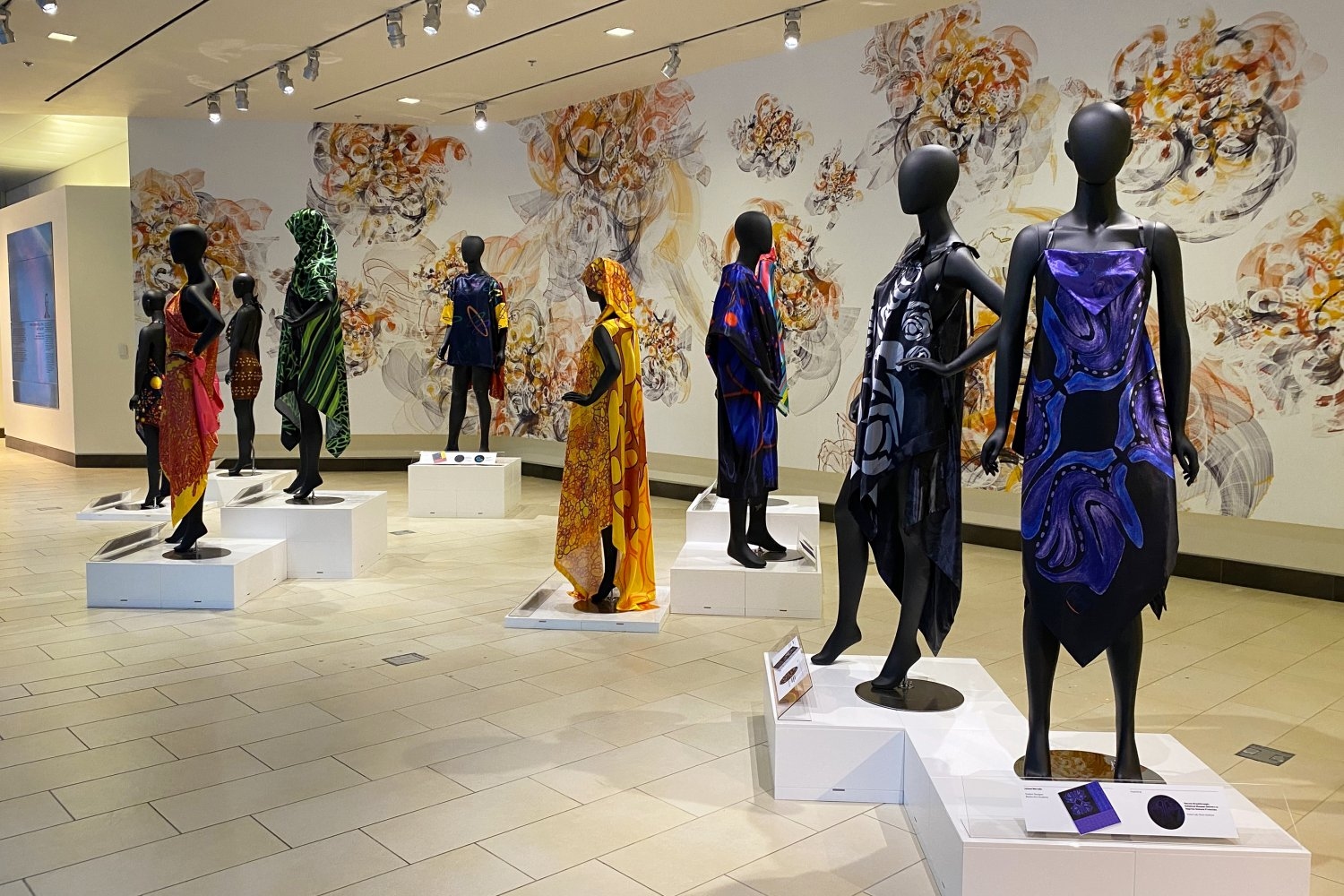
Boston teen designers create fashion inspired by award-winning images from MIT laboratories.
Erika Reinfeld | Koch Institute
Science Surfaces, a capsule collection of body coverings and accessories, serve as canvases for digital prints of ideas inspired by award-winning biomedical images produced by life science research labs at MIT.
The exhibition, now on display in the Koch Institute Public Galleries, is the result of the inaugural Peers + Pros Project, a Boston Fashion Week creative learning initiative catalyzed by the Cambridge Science Festival and sponsored in part by MIT’s Koch Institute for Integrative Cancer Research.
Fiona Shine Duncan, Emerald Garcia, Alison Benavides Lopez, and Jaileen Mercado are high school students in the Fashion + Tech program at Boston Arts Academy who were invited to be part of a team that included professionals at the Koch Institute, the Heide Maker Hub at the MIT Museum, Boston Public Library’s Teen Central, and School of Fashion Design, Boston.
“Science and technology are the new frontiers of fashion,” explains Jay Calderin, founder of Boston Fashion Week and lead mentor for the initiative. “This project has provided an invaluable opportunity for young fashion makers to collaborate with their peers and learn from industry professionals while exploring new ways of thinking about the design process.”
The collaboration began with a visit to the Koch Institute Public Galleries to tour the 2022 Image Awards exhibition and learn about the science behind the images. Selected by a panel of judges for both their scientific content and the visual impact, the 10 images on display offered a wide spectrum of inspiration for the students.
“I was challenged to step out of my comfort zone and work with colors differently,” says Mercado. “I am one who typically works with darker colors and was pushed to try working with more lively colors, and ended up loving the results.”
After visiting the galleries, they formulated and refined their design concepts through research and development meetings about zero-waste design strategies in Teen Central at the Boston Public Library’s Copley Place branch.
“Zero-waste design thinking was an integral part of the creative process that helped to develop the collection of the Science Surfaces textiles,” explains Calderin. Each science-inspired graphic design was incorporated into a grid of interlocking pattern pieces that were then digitally printed onto the fabric in order to minimize waste.
“Once we learned that this project was focused on sustainability and creating zero-waste garments, it pushed us all to think outside of the box,” says Shine Duncan.
A series of hands-on 3D printing workshops at the MIT Museum’s Heide Maker Hub allowed them to expand their skill set and create accessories to accompany the textile design. Production support was provided by the School of Fashion Design, Boston.
“Learning how to design something using the 3D printer was challenging, but worth the effort,” says Garcia. “I was very proud of myself for learning how to use the software.”
The experience culminated in a “Walk + Talk” runway presentation as part of the Cambridge Science Festival’s Fashion Day and opening day of the 28th annual Boston Fashion Week. Professional models brought the science-inspired designs to life and audience members were treated to post-walk reflections from the teens, their collaborators, and the scientists whose images inspired their work.
“We were delighted to provide a literal stage for this powerful merging of art and science,” says Cambridge Science Festival Director Brooke Ciradelli. “Seeing people from all walks of life come together around the teens’ work really underscores our guiding principles — that science and technology are for everyone.”
“The experience of seeing my work on the runway made it all feel very real,” says Benavides Lopez. After the show, she met up with an MIT research team whose image contributed to one her designs.
Former MIT professor Krystyn Van Vliet described how touching it was for PhD student Mingyu Yang and research scientist Anna Jagielska, “to meet the young artist Alison, who took their one confocal epifluorescent optical snapshot (representing literally years of scientific and technical troubleshooting with cells and materials and life) and turned into flowing beautiful walking artwork.”
The designs, and the images that inspired them, are on display in the Koch Institute Public Galleries through April 30. Visit Monday through Friday, 9 a.m. to 5 p.m., to see the collection up close and learn more about the design process in the students’ own words.
